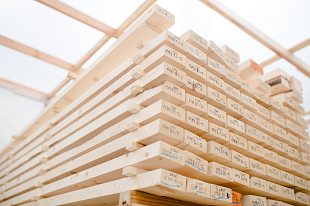 Friday, September 27, 2024
Friday, September 27, 2024  Friday, September 27, 2024
Friday, September 27, 2024 
As people become increasingly interested in the sustainability in all things, building construction was bound to find itself under scrutiny. Steel and concrete are notorious for their large environmental footprints. But they’ve historically been the only suitable answer as the primary load-bearing material for large, and especially tall, buildings.
That may be changing. Mass timber – engineered wood members used as structural components for buildings – is getting a lot of attention lately. “Mass timber is very exciting. It’s a long-term durable product. It’s a critical carbon storage tool,” said Mark Rudnicki, Ph.D., Professor of Practice for Forest Biomaterials at Michigan Technological University and Executive Director for the Michigan Forest Biomaterials Institute. “Plus, it’s cost-effective, and aesthetically pleasing.”
The carbon storage element is a big part of the new interest in mass timber. The production of steel or concrete emits large quantities of carbon dioxide (CO2). Wood is produced naturally when trees grow, and they “inhale” CO2 in the process, chemically locking it away. So long as the wood doesn’t rot or burn, the CO2 stays locked away. Using wood as a building material keeps the carbon captured until the building is destroyed and the wood degrades. A 2014 study published in the Journal of Sustainable Forestry calculated that a 14% to 31% reduction in global CO2 emissions could be realized by substituting wood for concrete and steel in building and bridge construction.
There are a number of different types of mass timber, distinguished by assembly and joining methods. The most popular recent development in mass timber is cross-laminated timber (CLT), in which pieces of wood are joined with adhesive in a staggered pattern in which each piece is at right angles to the next, imparting greater strength to the finished member product. One producer of CLT is SmartLam North America, which was reorganized in 2019 to support the growing mass timber market in North America. The company is an expansion of SmartLam, a company that has been an industry leader in CLT since its inception in 2012 as the first U.S. manufacturer of CLT. SmartLam North America is headquartered in Columbia Falls, Montana. The company announced in October that it had acquired the former IB XLam facility in Dothan, Alabama, increasing its annual CLT production capacity to six million cubic feet.